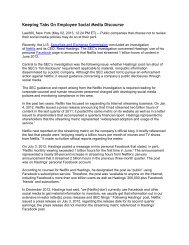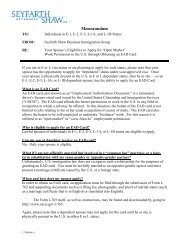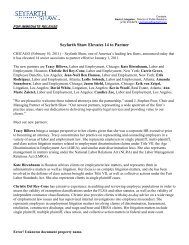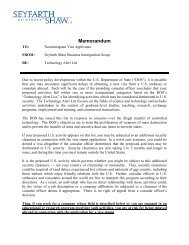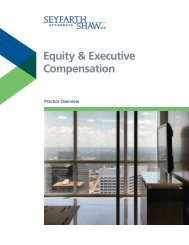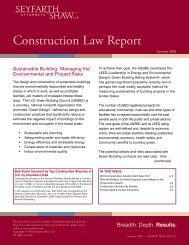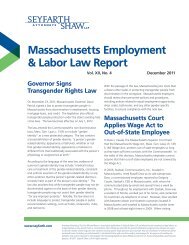Seyfarth Insight - Seyfarth Shaw LLP
Seyfarth Insight - Seyfarth Shaw LLP
Seyfarth Insight - Seyfarth Shaw LLP
You also want an ePaper? Increase the reach of your titles
YUMPU automatically turns print PDFs into web optimized ePapers that Google loves.
<strong>Seyfarth</strong> <strong>Insight</strong><br />
Mining Discrimination Charge Data: What Your<br />
EEO-1 Reports Aren’t Telling You<br />
By: Rebecca Pratt Bromet<br />
When asked “where are the diversity issues in your company,” most employers immediately turn to their employee<br />
demographics, be they EEO-1 reports, human resources information systems, etc. Naturally, comparatively low numbers<br />
of particular minorities may signal issues. An expensive statistical analysis may also reveal other problem areas. But is that<br />
enough?<br />
One often overlooked but crucial piece of information when assessing the overall “diversity health” of an employer is<br />
considering the nature and number of discrimination complaints. As we have reported [http://www.workplaceclassaction.<br />
com/eeoc-litigation/employers-beware---the-eeocs-fy-2011-eeoc-annual-performance-and-accountability-reportconfirms-its/],<br />
employers faced an all-time record of charge filings with the EEOC in the agency’s 2011 fiscal year. Those<br />
statistics are extremely helpful to track litigation trends across the country, and are closely scrutinized by in-house and<br />
external lawyers trying to read the tea leaves of how to best prevent future litigation. But these same statistics examined at<br />
the company level give us a unique window into the perception of diversity by an employer’s own workforce.<br />
For most companies, a charge filed with the EEOC is a matter for the legal department. The charge is handled by either<br />
in-house or external counsel, and human resources and operations are often asked to assist with those investigations. A<br />
discrimination charge is viewed as a threat, and there is typically a “circle the wagons” mentality when responding to that<br />
threat. A frequent goal when responding to the charge is often to compartmentalize the problem and insulate it from<br />
spreading. Employers will strive for a swift response that will have the least impact on day-to-day operations. Once that<br />
threat is addressed, and the charge is dismissed or otherwise resolved, most employers want nothing to do with revisiting the<br />
issue. This may be a lost opportunity. A discrimination charge - regardless of the merits of the allegations - is a barometer<br />
of employee perception of fairness in the workplace. Naturally, there will be opportunistic claimants who are only out to<br />
squeeze undeserved money from the employer. But most who file a charge have sincere (albeit misguided) feelings that<br />
there is a problem. Hiring and promotion claims are particularly important to consider when getting a ground-level view of<br />
employee perceptions of diversity.<br />
One challenge is collecting this information. Charges typically live in legal or some insulated arm of HR or operations. The<br />
nature of the charge, where the charge was filed, and the specifics of the allegations are seldom tracked, or if they are, the<br />
data is kept only for legal review. With the proper database tool, however, a company can efficiently compile charge data<br />
for current and historical charges. Employers can develop these programs themselves, or use pre-existing tools like <strong>Seyfarth</strong><br />
<strong>Shaw</strong>’s Charge Tracker program to develop their charge database. As each new charge arrives, it should be logged into this<br />
database. If the opportunity and resources exist, historical charge data should be added to this tool. The more data that is<br />
collected, the more trends will emerge. With some foresight and discipline, a database can be developed that will be useful<br />
not only for legal, but for those focused on diversity issues as well.<br />
<strong>Seyfarth</strong> <strong>Shaw</strong> — <strong>Seyfarth</strong> <strong>Insight</strong> |
<strong>Seyfarth</strong> <strong>Shaw</strong> — <strong>Seyfarth</strong> <strong>Insight</strong><br />
Once an employer has all of its charge data in one place, there are a number of different analyses it can conduct. The types<br />
of analyses are limited only by one’s imagination, but some examples:<br />
• Benchmarking against national trends - How do the charges stack up against national charge trends? Are there, for<br />
example, more race claims than would be expected based on EEOC national data? That could represent an employee<br />
perception that the workforce is not diverse vis-a-vis a particular protected group.<br />
• Geographical/operational trends - Are there particular hot spots, either in a given operational division or<br />
geographical area? It may be wise to consider more focused diversity attention to those areas, even though the raw<br />
EEO-1 numbers would otherwise suggest that all is well in that region/business unit. A geographical analysis may also<br />
reveal problem areas before they attract EEOC attention.<br />
• Year-over-year comparisons - Comparing how particular categories of charges are increasing or decreasing over<br />
time is also a key consideration. Significant increases in failure-to-hire cases, for example, would require a qualitatively<br />
different response than an increase in harassment claims. Simply examining the total number of charges, however,<br />
would not expose these distinctions.<br />
Of course, data analysis is only useful if it translates to action. The real challenge is taking these trends and converting<br />
them into a plan for addressing diversity issues in the workplace - be they real or perceived. For example, if the data<br />
shows that the employer has more than expected gender discrimination claims compared to national benchmarks, this may<br />
suggest revisiting hiring and promotion policies to determine if there may be “glass ceiling” or “sticky floor” problems. A<br />
spike in failure-to-promote claims for a certain racial or ethnic group would signal that the company’s diversity efforts are<br />
potentially ineffective or, at a minimum, not being effectively communicated. A disproportionate number of age charges in a<br />
geographic region or operating unit may prompt an employer to focus additional diversity training in that area. The point is,<br />
simply relying on employee demographic data is not enough. Discrimination charge data provides unique and critical insight<br />
into a workplace - a view that is lost if ignored.<br />
A modified version of this article originally appeared in Diversity Executive Magazine January/February 2012: http://www.<br />
nxtbook.com/nxtbooks/mediatec/de_20120102/#/50<br />
www.seyfarth.com<br />
Attorney Advertising. This is a periodical publication of <strong>Seyfarth</strong> <strong>Shaw</strong> <strong>LLP</strong> and should not be construed as legal<br />
advice or a legal opinion on any specific facts or circumstances. The contents are intended for general information<br />
purposes only, and you are urged to consult a lawyer concerning your own situation and any specific legal questions<br />
you may have. Any tax information or written tax advice contained herein (including any attachments) is not intended<br />
to be and cannot be used by any taxpayer for the purpose of avoiding tax penalties that may be imposed on<br />
the taxpayer. (The foregoing legend has been affixed pursuant to U.S. Treasury Regulations governing tax practice.)<br />
© 2012 <strong>Seyfarth</strong> <strong>Shaw</strong> <strong>LLP</strong>. All rights reserved.<br />
Breadth. Depth. Results.



